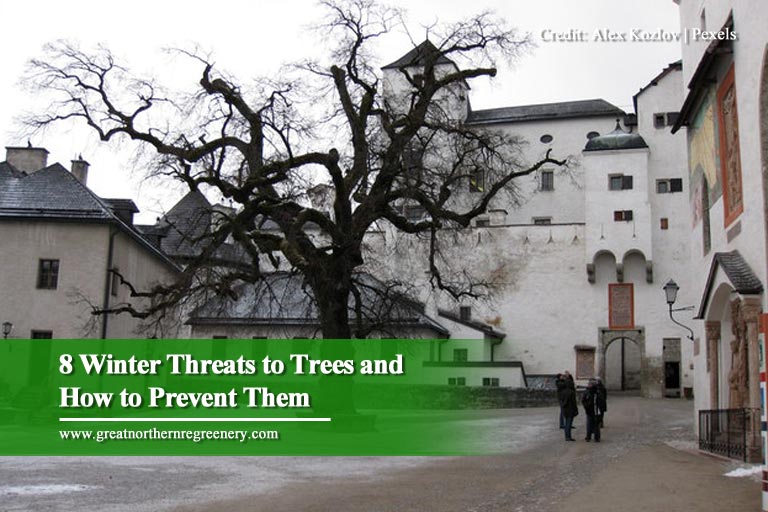
Extreme winter conditions can have a damaging impact on trees and shrubs. Cold temperatures can dehydrate their leaves, damage their bark, and kill their flowers, branches, and roots.
Some human and animal activities can also lead to tree health issues in winter. Salting the roads and sidewalks can affect the soils, while animals that resort to eating bark and twigs because of food shortage can endanger trees and shrubs.
Learn more about the 8 common tree care issues you can encounter along with some recommendations on how to protect your trees in winter.
1. Low Temperatures
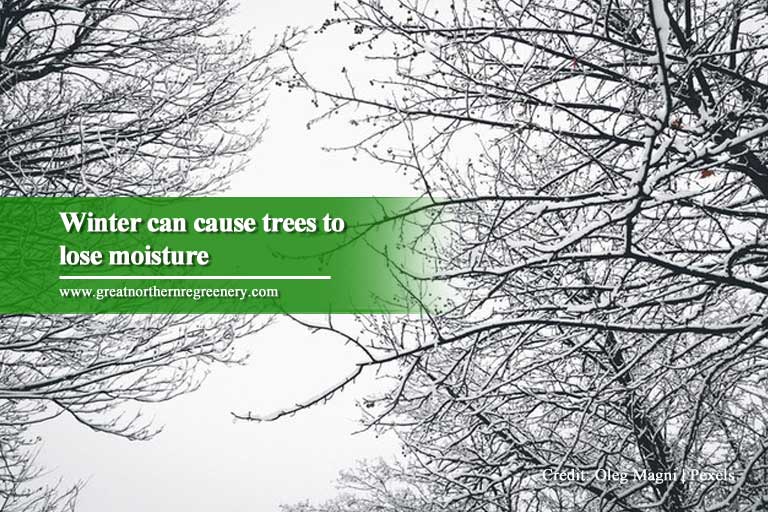
There are cultivars of tree and shrub species that are prone to injury when temperatures begin to dip below their minimum tolerance levels. Trees and shrubs that were previously exposed to stress conditions are likely to suffer greater injury in the wintertime.
Some species may survive mild winters but sustain injury from more frigid winters. Flower buds are among the parts that can get hit the hardest. If you have plants with marginal hardiness, make sure to grow them in protected sites like sheltered areas or courtyards.
2. Winter Burn
The browning or bleaching of the leaf tip of evergreen foliage during late winter or early spring is an indication of winter injury. It is called winter burn. Studies suggest that winter burn can occur due to the following reasons:
- The sunny weather warms the tissue of a tree, promoting cellular activity. As the sun sets, the temperature of the tree declines to harmful levels. This can kill the activated tissues.
- Cold temperatures cause the death of tree tissue, hence the browning of the leaves.
- The sun and wind trigger moisture loss during winter. Since a tree’s roots are frozen, they cannot replace the water lost. This causes the browning of the plant’s tissue.
- Sunny winters destroy the chlorophyll in the plant. Trees do not re-synthesize in environments with temperatures below 28°F. As a result, bleaching takes place.
Winter burn can be prevented by placing burlap as a barrier on all sides of the plant. When placing tree covers for winter, leave the top open to let in air and light.
3. Sunscald
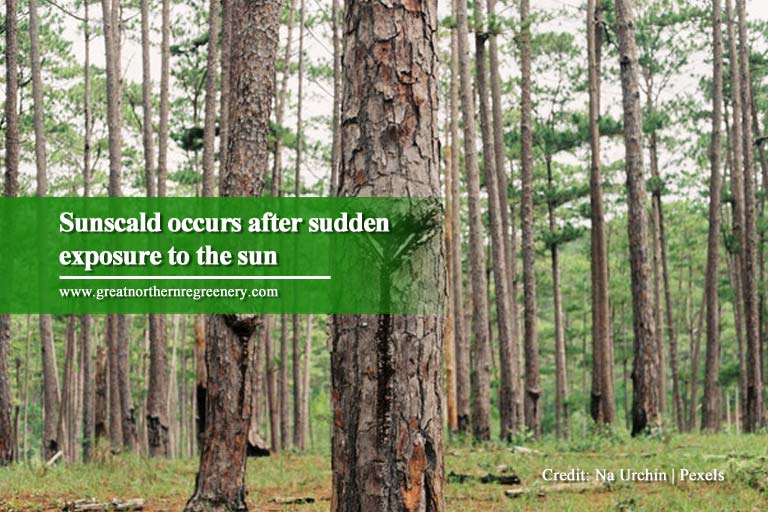
Sunscald is a long canker on the trunk of a tree. It is common in trees with thin bark like willow, maple, beech, and linden. Sunscald usually appears on the south or southwest areas of trees after being exposed to direct sunlight.
During winter, the temperatures in this area may reach 20°F. This temperature change is believed to cause the de-acclimation (reduction of hardiness) of tissue in the trunk. As a result, the bark turns reddish-brown, becomes rough, and tissue gradually cracks and falls away.
As much as possible, thin-barked trees must be planted in shaded areas or be protected by solid fences or evergreens. You can also put up a board on the southwest side of the tree (close to the trunk) to give it shade.
4. Frost Cracks
Also called radial shakes, frost cracks are longitudinal cracks that appear in the trunk of trees. These cracks commonly appear when winter temperatures reach 15°F. Cracks often affect the south or southwest part of trees since these are the areas that are exposed to temperature changes during day and night.
Temperature fluctuations can cause the external layer of wood to contract faster compared to the internal layer. Frost cracks can appear annually in trees. The following tree species are most prone to cracks:
- Oak
- Walnut
- Willow
- Red maple
- London plane
- Crabapple
Routine pruning may help prevent frost cracks. Trees that are susceptible to frost cracking, particularly trees with thin or smooth bark, can also be protected by applying white latex paint to the trunk. This is because the light colour reflects sunlight and minimizes temperature changes.
5. Salt Damage
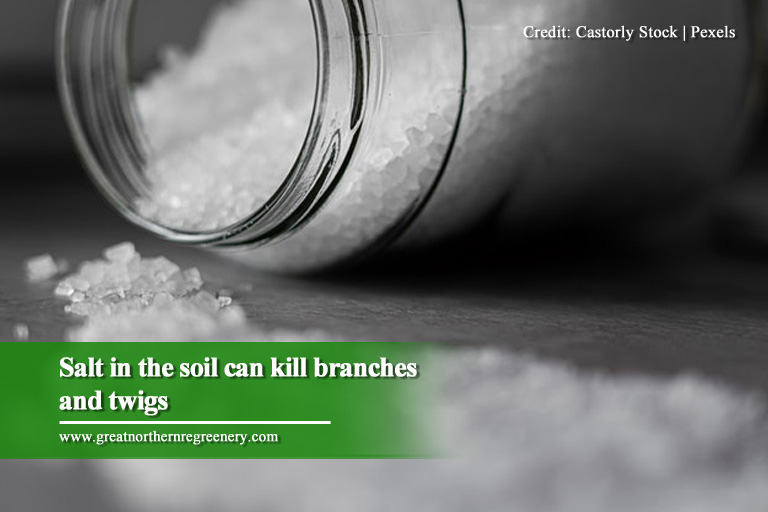
The use of salts to get rid of ice in the pavements can do more harm to trees and shrubs than good. The ill-effects of salts to plants are leaf scorch, browning of the evergreens, and branch dieback. Aerial deposits can threaten the health of branches and twigs.
Here are some tips to lower the damaging impacts of salt on your trees in winter:
- Instead of salts to de-ice driveways and sidewalks, use coarse sand. If you really must use salt, limit the amount and apply it before the area gets frozen.
- Put up barriers around damage-prone trees and shrubs. Burlap, snow fencing, or plastic fencing can help protect newly-planted trees from damage.
- During spring, flush the soil with water once it thaws. This helps remove salt residue from the root zones.
- Improve the drainage around your trees to leach away the salt.
- Keep your plants healthy. A healthy tree can stand up to the damaging effects of salt spray.
- Plant salt-resistant trees along the roads and walkways. These trees include birches, red oak, and poplars. Avoid planting trees like sugar maple, spruce, white pine, and basswood in areas where salt is usually sprayed since these tree species are intolerant to salt.
6. Frost Heaving
This tree injury happens when the soil freezes and thaws frequently. This can force small and shallow-rooted plants out of the ground and expose them to wind desiccation.
To avoid frost heaving, apply a layer of mulch. The mulch serves as an insulator to lock in moisture in the roots. If frost heaving has already happened to your plant, replant it after the soil has thawed.
7. Animal-Caused Damage

Rabbits and mice can also damage trees during winter by means of girdling. They feed on the bark when there’s a food shortage, which usually happens during prolonged and heavy snow cover. Mice feed on the ground part, while the rabbits nibble on the bark above the snow. Mice can cause severe damage to a tree when it’s surrounded by weed, grass, or mulch. Avoid putting much near trunks and branches.
To keep out rodents from your trees, protect your trunk and branches by wrapping them. Here’s how to wrap a tree for winter:
- Using hardware cloth or screen wire, wrap the low branches and trunk of a tree. Cover from below the ground line up to the part that’s within a rabbit’s reach.
- Avoid mouse damage by maintaining an area at the base of the tree that’s clear of grass or weeds.
8. Breakage Due to Snow and Ice
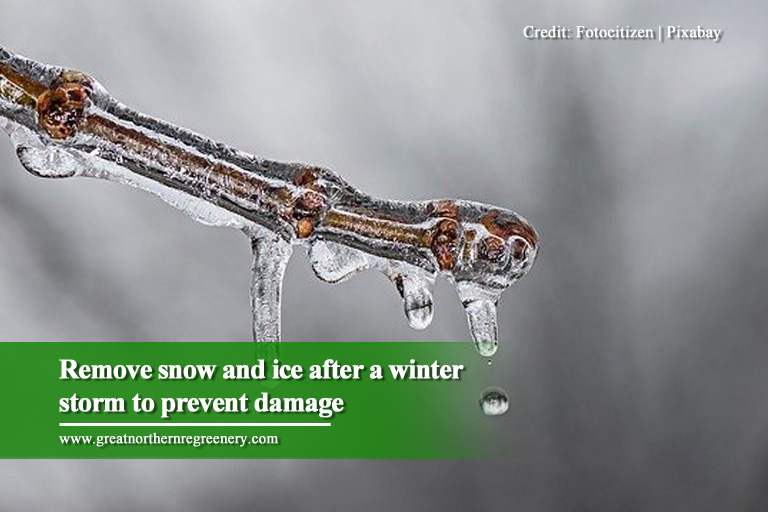
Massive snow and ice storms can cause severe damage to trees in winter. They can cause the branches of multi-stemmed trees to bend and break. As a protective measure, tree cabling and bracing are done before winter to prevent limb breakage. Contact a professional arborist who can safely tie the branches of your trees together. The earlier you do this, the better.
Hardwoods like birch, maples, and Siberian elm tend to get badly damaged during snow and ice storms. Not removing ice or snow from trees or plants can cause greater damage. Remove heavy snow before it freezes the limbs and branches. Let the ice encasing branches melt off over time to prevent additional damage.
When you need an expert arborist who can assist you in protecting old or newly-planted trees from winter damage, Great Northern ReGreenery is always at your service. We provide a wide range of tree care services to keep your trees and shrubs in top shape all year round. Call our toll free number 1-877-775-7444 or (905) 775-7444.





